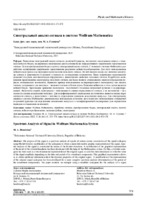| dc.contributor.author | Гундина, М. А. | |
| dc.coverage.spatial | Минск | ru |
| dc.date.accessioned | 2021-04-08T08:14:52Z | |
| dc.date.available | 2021-04-08T08:14:52Z | |
| dc.date.issued | 2021 | |
| dc.identifier.citation | Гундина, М. А. Спектральный анализ сигнала в системе Wolfram Mathematica = Spectrum Analysis of Signal in Wolfram Mathematica System / М. А. Гундина // Наука и техника. – 2021. – № 2. – С. 173-178. | ru |
| dc.identifier.uri | https://rep.bntu.by/handle/data/90021 | |
| dc.description.abstract | Выполнены спектральный анализ сигналов различной природы, построение скалограммы сигнала с помощью вейвлета Морле, модификация скалограммы для получения более информативного графического представления сигнала. Путем преобразования Фурье строится спектральный анализ сигнала. С помощью системы Mathematica разработана модификация графического представления результата вейвлетпреобразования. Для этого использовалась вейвлетскалограмма как двумерное представление исходного сигнала. На ней введена шкала для значения амплитуды сигнала в зависимости от времени и периода ее составляющих компонентов. Такое графическое представление позволяет получить дополнительную информацию о динамических свойствах исходного сигнала. Разработана модификация представления скалограммы исходного сигнала для более полного спектрального анализа (определение периода составляющих компонент). Приведен пример использования модифицированной скалограммы для анализа сигнала, содержащего два импульса – звукового сигнала и белого шума. Базисным вейвлетом в этом случае является вейвлет Морле. Произведено сравнение скалограмм – полученной с помощью встроенной функции и модифицированной. Недостаток первой скалограммы – невозможность оценки периодичности сигнала, а ее достоинство – возможность оценки локализации импульса. Для модифицированной скалограммы достоинством является оценка периодичности сигнала, а недостатком – неточность определения диапазона локализации импульса. Для спектрального анализа в системе Mathematica рекомендуется использовать сочетание двух подходов (использование стандартной встроенной функции для определения локализации импульса) и модифицированной скалограммы (для определения периодов составляющих компонент). | ru |
| dc.language.iso | ru | ru |
| dc.publisher | БНТУ | ru |
| dc.title | Спектральный анализ сигнала в системе Wolfram Mathematica | ru |
| dc.title.alternative | Spectrum Analysis of Signal in Wolfram Mathematica System | ru |
| dc.type | Article | ru |
| dc.identifier.doi | 10.21122/2227-1031-2021-20-2-173-178 | |
| local.description.annotation | The purpose of this paper is a spectrum analysis of signals of various nature, construction of the signal scalogram using Morlet wavelet, modification of the scalogram to obtain a more informative graphic representation of the signal. Spectral analysis of the signal is constructed by means of the Fourier transform. A modification of the graphical representation of the result of the wavelet transform has been developed with the help of the Mathematica system. For this, a wavelet scalogram has been used as a two-dimensional representation of the original signal. A scale has been introduced on it for the value of the signal amplitude depending on the time and period of its constituent components. This graphical representation allows us to obtain additional information about the dynamic properties of the original signal. A modification of the representation of the original signal scalogram has been developed for a more complete spectrum analysis (determination of the period of the constituent components). The paper contains an example using a modified scalogram for the analysis of a signal containing two pulses, an audio signal and white noise. The basic wavelet in this case is the Morlet wavelet. A comparison of the scalogram, obtained using the built-in function, and the modified scalogram has been made in the paper. The disadvantage of the first scalogram is the impossibility of assessing the frequency of the signal; its advantage is the ability to assess the localization of the pulse. For a modified scalogram, the advantage is the estimation of the signal periodicity, and the disadvantage is the inaccuracy in determining the range of pulse localization. For spectrum analysis in Mathematica, it is recommended to use a combination of two approaches (using a standard built-in function to determine the localization of the pulse) and a modified scalogram (to determine the periods of the constituent components). | ru |

